Imagine this: you turn on your computer, and instead of your files, you see a message demanding money to get them back. It’s frustrating. It’s stressful. It feels like you’ve lost control. That’s what ransomware does—it locks your files and holds them hostage.
The worst part? It can happen to anyone. Whether you’re running a small business, managing a team, or just storing personal photos, ransomware doesn’t discriminate.
But here’s the good news: you can protect yourself. There are simple steps to stop ransomware before it strikes. You don’t need to be a tech genius. Just a few smart moves can save you from a lot of headaches.
Stick with us, and we’ll show you exactly how to prevent ransomware.
Key Takeaways:
|
Types of Ransomware
Before we jump into prevention, let’s understand the enemy. Ransomware isn’t one-size-fits-all.
| Type | What It Does | Example |
| Encrypting Ransomware | Locks your files by encrypting them. You can’t open them without a key. | WannaCry |
| Locker Ransomware | Locks your entire screen or device. You can’t use it at all. | Police Locker |
| Scareware | Sends fake alerts to scare you into paying money. | Fake antivirus popups |
| Double Extortion | Threatens to leak your sensitive data if you don’t pay. | Maze |
| Ransomware-as-a-Service | Ransomware sold to criminals who then target others. | REvil |
Each type is dangerous in its own way. Now, let’s focus on how to stop them.
Data on Ransomware Trends
| Year | Global Ransomware Damage Costs | Average Ransom Demand |
| 2020 | $20 billion | $178,000 |
| 2021 | $30 billion | $220,000 |
| 2022 | $42 billion | $258,000 |
**Key Insight: Prevention is always cheaper than recovery.
10 Best Ransomware Prevention Practices
Stopping ransomware isn’t as hard as it sounds, but it does need some focus. Let’s dive into ten smart ways to protect your data and network.
Below are the best protection for ransomware.
1. Keep Your Software Updated

Hackers love old, unpatched software. That’s their easiest way in.
- Always install updates when they pop up.
- Turn on automatic updates so you don’t forget.
**Example: In 2017, the WannaCry ransomware attacked thousands of outdated Windows systems. Don’t let that happen to you!
2. Use Strong Passwords

Weak passwords make life easy for hackers. Don’t give them that chance.
- Do this: Use long passwords with a mix of letters, numbers, and symbols.
- Don’t do this: Reuse the same password for multiple accounts.
**Pro Tip: Use a password manager to create and store strong passwords securely.
3. Enable Multi-Factor Authentication (MFA)

Passwords alone aren’t enough anymore. MFA adds another layer of security. Even if hackers get your password, they’ll need a one-time code or biometric verification.
- Set up MFA for email, banking, and important accounts.
4. Back Up Your Data Regularly

If ransomware locks your files, a good backup is your lifesaver.
- How often: At least weekly; daily for critical files.
- Where: Use both cloud backups and external drives (stored offline).
**Pro Tip: Test your backups occasionally to make sure they’re working.
5. Be Careful with Email Attachments

Phishing emails are the most common way ransomware spreads.
- Don’t click links or download attachments from unknown senders.
- Look for signs of fake emails: typos, weird email addresses, or urgent language like “Act Now!”
**Example: An email saying, “Your package couldn’t be delivered. Click here to check.” Don’t fall for it!
6. Use Anti-Ransomware Tools
Good security software can block ransomware before it even touches your system.
- Use reliable antivirus and anti-malware programs like Bitdefender or Malwarebytes.
- Keep them updated for maximum protection.
**Bonus: Some tools even scan emails and attachments for threats.
7. Segment Your Network

Don’t let ransomware spread through your entire network.
- Break your network into smaller sections.
- If one section gets infected, the others stay safe.
**Example: Keep sensitive business data on a separate server from regular employee files.
Ransomware Prevention for Networks
If you manage a network, follow these extra tips:
- Use a Firewall: Block unauthorized access.
- Install Intrusion Detection Systems (IDS): Identify threats in real-time.
- Limit User Privileges: Only give access to what’s necessary.
8. Train Your Team

People are your first line of defense. Make sure they know what to do.
- Offer regular cybersecurity training for employees.
- Show them how to spot phishing emails and recognize suspicious links.
**Pro Tip: Simulate phishing tests to see how well they respond.
9. Disable Macros in Microsoft Office

Ransomware often hides in macros inside Office documents.
- Go to Microsoft Office settings and turn off macros by default.
- Only enable them if you trust the source of the document.
**Why? Macros can run hidden scripts that infect your system.
10. Monitor Your Network Activity

Stay one step ahead by keeping an eye on your network.
- Use tools like Wireshark or SolarWinds to detect unusual activity.
- Watch for things like a sudden spike in data transfers or unauthorized logins.
**Pro Tip: Set up alerts for any suspicious activity.
If you want to learn how to prevent malware, phishing, SQL injection, or zero-day attacks, read our informative blogs!
What to Do After a Ransomware Attack
Getting hit by ransomware is tough, but don’t panic. Take a deep breath, and let’s go step by step to handle this calmly and effectively.
Below are the solutions for ransomware attacks.
1. Disconnect the Infected System

The first thing you should do is unplug the infected device.
- Disconnect it from the internet immediately.
- If it’s part of a larger network, isolate it so the ransomware can’t spread to other devices.
**Why? Ransomware can infect other computers and files quickly, especially in a connected network.
2. Report the Incident

Don’t keep the attack a secret—it’s important to notify the right people.
- If you’re in a workplace: Inform your IT team right away. They’ll know how to handle it.
- For personal devices: Contact local cybercrime authorities. In the UK, report to Action Fraud; in the US, report to the FBI Internet Crime Complaint Center (IC3).
**Pro Tip: Reporting helps authorities track and stop ransomware groups.
Visit this informative blog to get a detailed idea of how to prevent cyber attacks.
3. Don’t Pay the Ransom

It’s tempting to just pay and get your files back, but don’t.
- Paying doesn’t guarantee hackers will unlock your files.
- It also encourages them to attack others, keeping the cycle alive.
**Example: Research shows that even when victims pay, hackers often demand more money or never deliver the decryption key.
4. Restore From Backup

If you’ve been backing up your data (which you should), now’s the time to use it.
- Wipe the infected system clean to remove the ransomware.
- Restore your files from a backup copy.
**Pro Tip: Make sure your backup isn’t connected to the infected system—ransomware can lock those files, too, if they’re accessible.
5. Hire a Cybersecurity Expert

If you’re not sure how to handle this on your own, get professional help.
- A cybersecurity expert can remove ransomware safely.
- They can also check your system for vulnerabilities and secure it against future attacks.
**Why? Ransomware often leaves backdoors that hackers can use to strike again. Experts can close those gaps.
With our Managed Cybersecurity Services at Bantech Cyber, we safely remove ransomware from your system. We find and fix weak spots to prevent future attacks.
Hackers leave hidden backdoors, and we make sure to close them for good.
Bonus Tip: Learn From the Attack
Once things are under control, review what went wrong.
- Was it a phishing email? An outdated system? A weak password?
- Use this experience to strengthen your defenses and avoid future attacks.
You can check out our detailed and insightful guide to learn all about cyber security.
Wrapping Up
So, coming to this point, we can assume that you now have a pretty good idea of how to prevent ransomware. Ransomware attacks can be devastating, but they’re preventable.
Regular updates, strong passwords, backups, and good cybersecurity tools can make a huge difference. Remember, it’s always better to prevent an attack than to deal with the aftermath.
Stay alert, stay secure, and keep your data safe.
What’s your plan to stop ransomware? Let’s chat about it! 😊
